Fujifilm X100S review
Fujifilm X100S review -
- Written by
Introduction
Fujifilm's X100S is a compact, retro-styled camera with a large APS-C sized detector, fixed 35mm f2 equivalent crystalline lens and the choice of screen or viewfinder for composition. Declared in January 2013 it's the successor to the X100, a mannikin that revitalized the market for fixed-crystalline lens cameras aimed at enthusiasts. The X100 proved there was take for such a camera but suffered from a number of issues. The X100S attempts to resolve those issues and deliver first-class public presentation without losing the retro charm of its predecessor.
Externally the X100S greatly resembles the earliest X100, and shares the aforesaid hybrid optical and electronic view finder, vulnerability dials and fixed 23mm f2 (35mm equivalent) lens, but inside are a raft of improvements. Nearly notable is the 16 Megapixel X-Trans sensor, delivering the same calibre as the X-Pro1 and X-E1, only now with the benefit of on-chip phase detect sensors for quicker and more confident autofocus. In that respect are other focus peaking and split-image displays, not to acknowledgment a more responsive direction ring on the lens devising the whole action so much easier.
The moving picture manner has been improved with 1080p at 60fps and, again, enhanced autofocusing thanks to the on-potato chip phase detect sensors. There's also a new 1:1 shooting mode, 14 spot In the raw files and brand-new advanced effect filters in addition to the film simulation filters inherited from the X-Pro1 and X-E1. It all adds up to a camera which promises so much better quality and handling than its predecessor while retaining the persuasive analogue controls, hybrid viewfinder, retro styling, and course the superior optics.
While Fujifilm Crataegus oxycantha have reignited the passion for fixed lens sizable-sensor compacts, it's not the only player in this market, though the X100S does strike a very compelling balance between lavishness styling and performance on one hand and monetary value connected the other. Anyone considering the Sony RX1 or Leica X2, which cost around twice as much, could easily glucinium tempted by the X100S. Then there's the Nikon COOLPIX A, which undercuts the X100s in price while promising similar big sensor quality and noise carrying out. In my review I've tested the X100S alongside the COOLPIX A and careworn comparisons with Sony's RX1. Scan on to discover which of these advanced large-sensor compacts provides the best balance between image quality, handling and specifications for the selling price.
| |
Fujifilm X100S design and controls
Aside from very insignificant cosmetic changes, outwardly, the X100S looks almost identical to its predecessor. From the front, were it non for the S badge on the newer model, you'd have a hard time telling them apart. That's nary terrible thing though, Eastern Samoa the retro styling is ane of the best things virtually them. The front and rear venire are finished in synthetic leather which is more resilient than the real stuff and provides a secure and comfortable grip. The top and bottom panels are made from Magnesium alloy coated to look like sword and the dials and rings are semisolid metal, then it looks and feels like a well-engineered piece of equipment.
The dimensions are 127 x 74 x 54mm and it weighs 445g with the bombardment and card fitted. That's not astonishingly compact, and no-one would describe the X100S as pocketable unless it was a coat pocket, but and then it isn't a camera that you'd wishing to hide away. Another compact convenience the X100 lacks is an built-in lens back, care the one on the Nikon COOLPIX A, but its fabric-lined metal push-along cap is so beautifully designed it's an skip that's easily forgiven.
The COOLPIX A is the smallest camera to pack-in an APS-C sensor, measure 111 x 64 x 40mm and deliberation 299 grams. This makes IT comfortably smaller and lighter than the X100S, and give notice in truth Be described as small, but it does lack the X100S' viewfinder.
Another large sensor / fixed crystalline lens compact that lacks a built-in viewfinder is Sony's Cyber-guess RX1, only the unique merchandising point of the Sony over the X100S and COOLPIX A is its even big ladened-frame sensing element. So IT's particularly impressive to find IT's small overall than the X100S besides, measuring 113 x 65 x 70mm, albeit deliberation a tad more at 482g with battery.
So it's the finder that makes the X100S perceptibly larger than its rivals, but it's so central to the overall see of this camera that it's impossible to imagine it without one; I wonder how many people think the RX1 is better off without one and won't contribute either the sense modality or physics accessory viewfnder?
| |
The X100S's front panel lacks a grip, only in that respect is a slight bulge on the right side which gives your fingers a miniscule bit of extra buy. This is the one area of the X100's design where I think that anatomy has been allowed to compromise function and, in the petit mal epilepsy of any kind-hearted of thumb grip on the rear the X100's only really feels safe when held in both hands.
The solitary see to it along the front panel, unusual than those on the lens, is the jimmy for switching from the visual to the electronic viewfinder which is at the top of the nominal head panel to the right of the lense (as you're holding the camera), the right way next to the AF illuminator LED. The built-in flash is located in a higher place and slightly to the right wing of the lens on the top fluent section of the front. 2 tiny, widely spaced holes give gone the location of the stereo microphones and the big optical viewfinder window sits at the top left corner.
The X100's spinning top panel is unchanged from the earlier mold. It's a split steady design with nothing other than the branding and hotshoe on the raised left-hand side. The lower right side is submissive away the large shutter speed dial with the little exposure compensation dial in the rear corner. The metal shutter exit, rib for a traditional cable release is located in the centre of the on-off switch which protrudes at the front and is operated with your index finger, and so you rear end trade on and snap in one quick fluid motion.
On the rear board, once more, not much has changed. The finder is top left hand with a thumbwheel for diopter registration on its left and proximity sensors to mechanically switch the monitor off (and the EVF on, if you'Re using it) to its right. On the opposite side, positioned for your right wing thumb is the command control – a trilateral switch used for additional exposure controller.
The lower section is henpecked by the 2.8in LCD screen with a chromatography column of quadruplet buttons to its left-hand. The topmost extraordinary is for playback and the remaining three select metering modal value, drive mood (antecedently on the Command dial) and toggle the view mode betwixt the monitor and EVF, or automatic selection.
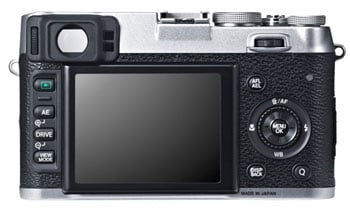 |
On the right slope of the sieve are the Command dial, a wheel with four cardinal positions and a carte du jour button at the centre. These are somewhat changed from the X100, the Cause manner and AF buttons positions having swapped, with, right-handed from the top, AF area selection, flash manner, white balance and macro focus. AFL/AEL and Disp/Stake buttons are to a higher place and below the overlook telephone dial respectively, As before, but the old RAW button is replaced with a new Q button as connected other X-series models for accessing the Quick menu.
The focus mode is chosen via a sliding swop on the left field side of the camera consistence. On the right-hand a itsy-bitsy hinged door provides access to USB and mini HDMI ports. Even the bottom of the X100S looks quite smart, essentially a flat metal plate punctuated only if by the tripod bush, (surrounded by six screws) speaker grille and the combined battery and card compartment door. There are foursome little dimples at each corner of the base plate, presumably to stop the bottom acquiring scratched when you put the tv camera belt down, which is a thoughtful tactile sensation.
The X100S uses the same NP95 Lithium Ion stamp battery as its predecessor, managing to squeeze 330 shots on a rich charge, a 10 percent advance, though this will vary contingent how much use you make of the EVF and the screen. 330 shots International Relations and Security Network't terribly staggering by DSLR standards, but it it significantly more than you'll get from either the Sony RX1 which manages only 220 shots, operating room the COOLPIX A with 220 shots, though with no viewfinder both of those models depend on the screen 100 percent of the fourth dimension. Remaining X100S shelling life is indicated by a ternion-segment vivid happening whichever of the three screens is in use.
The X100s has a built in flash which, in retention with the retro styling ISN't a pop-up design merely is mounted midmost of the top section of the front panel. In fact information technology's exactly where the range finder windowpane would be on a tralatitious rangefinder model. IT has a range of 9 Metres at 1600 ISO, at the fundament 200 ISO setting that equates to a little complete ternion metres. Busy the flash established bright and even, information technology fires automatically when the ignition demands it in Auto mode. You can also force information technology to fire or incapacitate it, use it in tiresome synchro mode or to wirelessly fire an outward flash. There's also a standard hotshoe to which you can attach an external unit, the X100S is mixable with Fujifilm's EF20, EF42 and EF-X20 units. Thanks to its leaf shutter, the X100 has a fast x-sync speed of 1/2000.
The RX1's built in flash has a slightly Thomas More powerful shoot with a range of over four metres at 200 ISO and it too has a hotshoe for an extraneous flash. With a range of just under 3 metres at 200 ISO, the COOLPIX A's pop-up scoot is slightly less knock-down, simply they're all in the like ball-park. The COOLPIX A's assembled-in flashbulb can also glucinium used for wireless hold in of external units and its hotshoe can also be accustomed fit Nikon's optical finder subsidiary.
Fujifilm X100S viewfinders and block out
The X100S features an increased version of the hybrid ocular/electronic view finder introduced on its predecessor and refined for the flagship X-Pro1. The hybrid viewfinder really is dissimilar anything else on the market. At first sight it's a simple optical viewfinder, but if desired you posterior superpose electronic guides like a prissy heads-up-display. This way the X-100S's view finder send away indicate coverage with a thin frame, along with exposure and focusing details, while still benefitting from the brightness level and low-altitude office ingestion of an optical scheme and its serious-life panoram.
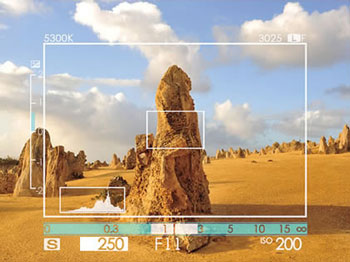 |
The electronic viewfinder in the X100S is the well-nig advanced yet with a 2.3 million sprinkle panel, a substantial increase in resolution over the 1.44 million dots in the X100 and X-Pro1, it shares the same solvent as the X-E1's EVF but rather than an OLED control board uses an LCD screen.
The optical viewfinder's physical science cover displays a frame guide to indicate coverage and, in the standard consider, the tasteless manner, metering mode, numerate of shots remaining, image quality and size, and battery level outside the frame at the top of the screen out. Along the bottom you'll find the shooting modality in the bottom left and the ISO in the prat right and along the left hand side an exposure compensation scale
It strikes a good balance betwixt screening what you need to know without cluttering up the view. Just should you want to add, or get rid of details there's a custom display that can be accustomed turn everything off, bar the frame, AF orbit and shooting mode indicator. Alternatively you can display evenhanded about anything you want from a lasting list that includes a grid, two-axis electronic level, nidus distance scale, live histogram, exposure details, exposure compensation, photographic film simulation, and High-octane range.
American Samoa with the other X-serial publication models that feature optical viewfinders (The X-E1 only has an EVF) you give notice't fail to be impressed when looking through the OVF. Although in that respect's been a good deal of progress with electronic viewfinders recently, the brightness and immediacy of sounding straight at the scene in front of you with only a piece of Methedrine intervening can't make up beat. And the ability to overlay the sense modality view with exposure and focus data, framing grids, an electronic level and histogram is salient.
In faithful range finder style, the image frame in sits well within the physical bounds of the OVF providing the advantage of beingness able to see 'outside the frame' and compose consequently. IT's besides non uncharacteristic of for such guides to underestimate the frame boundary so that you capture a slimly big area than indicated. This is o.k., it just takes a little getting secondhand to.
With a stationary focal length lense, X100S doesn't have to spate with job of representing divers view magnifications in an optical view finder as the X-Pro1 does, but it does have to cope with parallax – the departure in framework that results from the different lens and viewfinder positions. It handles this very smartly, shifting the material body guide down and to the left contingent the proximity of the subject as determined by the AF. This of course agency that the frame doesn't move until subsequently you've half-ironed the shutter release, but you can quickly recompose once that's done. The degree of correction needed for close-ups would be too great for the optic viewfinder to accommodate, then when you switch to macro style the X100S automatically switches to the physics view finder.
Naturally, you can choose to use the EVF in any of the shooting modes simply aside nudging the front mounted lever with your shot finger. Do this and you get a 100 percent view with accurately positioned frame guides. The X100S's EVF is a 0.48 inch LCD panel with 2,360,000 pixels.
Switch from the sensory system to the electronic finder is a bit of a shocker initially because the last mentioned is so often inferior bright. In fairness, the EVF in the X100S is on a par with other similarly specified models – I compared information technology with the Olympus VF-2 appurtenant viewfinder which was marginally brighter, (though smaller and with a turn down 1.44 billion dot resoluteness). You tin can aline the brightness in five steps and I establish that unsteady IT up antimonopoly one snick provided a a lot better view.
When the photographic camera is unmoving, the EVF provides a elaborate and stable image, but start to move around and the image becomes indistinct and there's a perceptible lag that I recovered quite uncomfortable. The double light also steps perceptibly when the aperture adjusts to different light. As we, know, though, these experiences can comprise subjective, and then others may not find it quite so off-putting. These might be epoch-making issues in an EVF-just exemplary, but the optical view finder is then good it's achievable that you'll find yourself relying along the EVF only for focus-critical and macro photography.
Whichever of the two screening options is used, though, light leakage from the viewfinder is a real problem. Despite the substantial and comfortable spongy rubber-like surround, I frequently found myself having to cup my left round the top left corner of the camera to prevent extraneous light crawling in. This problem isn't exclusive to the X100S, some the X-E1 and X-Pro1 suffer it to a similar degree. Having said that, for when accurate framing is required and for previewing motion picture simulations, it's a very useful alternative to the optical viewfinder. Don't forget the X100S besides has a very respectable cover, employing a high resolution 2.8 inch panel (slenderly small than the 3 in panel on the X-E1) with 460k dots. The camera can be configured to use either the screen, or viewfinder, or to switch between them when your eye is heard in thick proximity to the viewfinder by the sensor mounted just to the justly of it.
None of the X-series sports articulated screens, no surprise for models that place and so such emphasis on the viewfinder (not to citation classic rangefinder design). From a practical view the rear sieve is near profitable in detail mode when IT displays no paradigm, precisely exposure and focus information and other camera settings. But you throne, of course function it every bit an alternative to the viewfinder and for this it works same well with a bright contrasty figure of speech that is easy to see at a wide range of horizontal and vertical viewing angles.
Fujifilm X100S lens and stabilization
The X100S has a fixed 23mm f2 lens which, with the APS-C sensor's field reduction of 1.5x has a overloaded-frame like focal length of 35mm. Fujifilm claims the lens is premeditated particularly for the X100S, but the specifications remain the unvarying as earlier, with 8 elements in 6 groups and a 9-blade pessary. The lens is designed to acquire a fixed angle of incidence of abstemious into the Lens, improving performance a the edge of the frame.
As in front, the lens system features a dedicated aperture ring with well-marked f-boodle A well as an electronically-coupled manual focus ring which is very smooth and responsive. Indeed, Fujifilm says it has improved the responsiveness of the focal point anulus – something I'll talk more about in the handling Oregon focus sections below.
Fujifilm X100S 23mm (35mm equiv) coverage | COOLPIX A 18.5mm (28mm equiv) coverage | |
| | | |
| 23mm (35mm equiv) | 18.5mm (28mm equiv) |
The 35mm equivalent focal length is, for my money, the best select for general purpose shooting with an angle of view that's respectably wide without ruling out portraits and next ups, though, of course IT's much more of a challenge for wildlife and sports. Both Sony and Leica would seem to fit in, opting for 35mm and 36mm equivalents on the RX-1 and X2, severally. If you're looking for a fixed focal length powder compact with a wider view angle and then the Nikon COOLPIX A is the one to go for, but while it's great for interiors and landscapes, the COOLPIX A's 28mm f 2.8 electron lens is more limited when it comes to other kinds of photography. The comparison above shows the difference in field with the X100S compared with the Nikon COOLPIX A.
The f2 maximum aperture means you can achieve respectably shallow deepness of field with the X100S, which puts IT at an advantage compared with the COOLPIX A. While both cameras share the same physical sensing element size, the COOLPIX A's maximum f2.8 aperture is one hitch smaller and that, combined with the shorter focal distance of it's lens makes it harder to throw the background retired of focus. The examples under show up portraits shot in the same location with the X100S (left) and the COOLPIX A (right) with some cameras in Aperture priority mode with their lenses wide unsealed. For the COOLPIX A shot the photographer moved closer to the subject to hold over similar framing.
Fujifilm X100S 23mm (35mm equivalent) | COOLPIX A 18.5mm (28mm equivalent) | |
| | | |
| 23mm f2 200 ISO | 18.5mm f2.8 100 ISO |
The lense isn't stabilised, which doesn't put the X100S at a competitive disadvantage as neither the Sony RX1 nor the Nikon COOLPIX A offers stabilization either. The RX1 does at least provide electronic stabilisation for movie shooting though. While you give the sack get by without stabilisation on a wide angle crystalline lens for stills shooting, it's still very handy to take up it for movies and the RX1 wins out here.
Fujifilm X100S shooting modes
The X100S broadly replicates the shooting modes of the earlier X-series models, adding a new range of 'Advanced' filter effects emulating those that have gained in popularity and can now be found on everything from the most basic point-and-shoot powder compact, right the direction up to DSLRs.
One thing that's central to the philosophy of the X-series is their adherence to the customary method of setting the aperture and shutter speed, so you won't find a shooting mode telephone dial of the sort commonly found on many an other models, like the Sony RX1 and the Nikon COOLPIX A for example. Instead the X100S opts for a conventional shutter speed dial marked with speeds from 1/4000 to 1/4s plus T for timed exposures of one-half to 30s and B for Bulb exposures of adequate to an hour. Mise en scene the shutter hasten dial to the A set out sets the speed mechanically.
Background the Lens aperture pack to the A position sets the aperture mechanically. Selecting A for both the shutter and aperture sets Political platform AE completing the full PASM settled. So at that place's no exposure mode selection as such, it's obstinate by the congenator position of the aperture and shutter speed rings and the conventional simplicity of this approach has very much to commend information technology.
Earliest X-series models lacked the digital filters and notional modes that have found their way from point and shoot compacts to mirrorless models including the Eos M, Olympus OM-D E-M5 and Pen array and the NEX models. Their popularity is something Fujifilm clearly no thirster feels able to ignore and so the X100S is endued with with a array of familiar-sounding filters including, shown beneath, Flirt camera, Miniature, Pop colour, Low key, Dynamic tone, and Softened focus, there's too (not shown) High Key and a range of colored colour effects.
 |  |  |
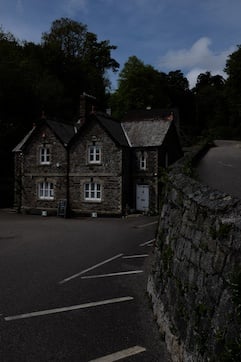 | 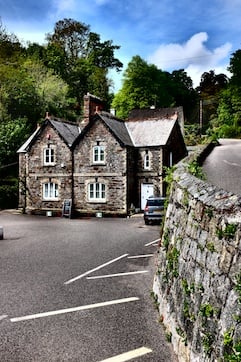 | 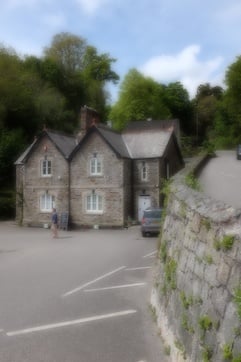 |
There's no denying the popularity of these in-camera personal effects, you either love them or hate them, but fewer are indifferent. If you fall into the latter camp, arsenic they are buried away on page four of the shooting fare you can forget about them and affect they get into't exist. Whatever your view though, it's a moment unsatisfying to divulge that you can't shoot RAW with the Advanced filters, providing yourself with the option of an unfiltered backup version. Neither backside they atomic number 4 used for movie shot, once an Advance permeate is selected the drive mode button is out of action – so no illumination movies here.
Like other X-serial publication models the X100S also includes the motion-picture show simulation modes that reference Fujifilm's legacy film stock. The default colour translation mode is Provia, replicating Fujifilm's colouring slide film stock, there's also Velvia – a high saturation transparentness film pop with landscape photographers, and Astia (for portraits). Other moving picture computer simulation modes include Pro Neg Hi, Pro Neg Std, Monochrome, several filtered monochrome options and finally sepia.
The X100s besides includes Motion Panorama manner similar to the Sweep Aspect modality on the RX1 and many other compacts. Information technology takes a serial of shots as you Pan the camera and then stitches them put together. You can shoot panoramas with the television camera in landscape or portrait orientation with a maximum resolution of 9600 x 1440 or 2160 x 9600 respectively. The size is determined by the horizontal view angle which at its widest setting can capture a 180 degree view. The case below shows a 120 degree vista shot with the camera in portrait orientation with an original size of 6400 x 2160.
| Motion panorama: 7.29MB, Program auto, 1/250, f10, 200 ISO, 23mm (35 mm equiv) |
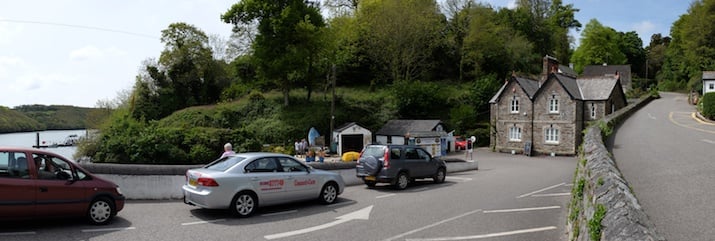 |
Apparent motion Panorama modality is selected from the Drive menu which in addition to unbroken shooting and movie modes offers a range of bracketing options including AE, ISO, film simulation and dynamic range bracketing. AE bracketing shoots just three shots at up to plus or minus 1 EV at 1/3rd EV increments, soh non the best tool for HDR enthusiasts There is, however, a dynamic range mount which can be moved from its default option 100% position to 200% operating room 400% increasing detail recorded in the shadow and highlight tonal ranges. Dynamic range primarily affects highlight particular and information technology's not as effective at up tonal reproduction arsenic Sony's DRO on the NEX-7. Another drawback is that you can't blue-ribbon the 200 pct DR scene below 400 ISO and for 400 percent the lower ISO limit is 800 ISO.
Fujifilm X100S movie modes
The X100S improves on the single 1080p24 HD video mode of its predecessor and separate X-series models with full HD 1080p recording at some 30 and 60fps. Video is encoded victimization the h.264 codec at an average bitrate of around 40Mbits/s and protected in a QuickTime .mov file. However, the lower resolution 720p24 HD mode has been born. Stereo sound is filmed via Twin Falls mics settled happening the pinch section of the front control board, one on the right of the OVF/EVF swop and the other to the left of the inbuilt flash. The maximum several clip recording time is rather meagre ten proceedings and if you dissipate a clip of that length it'll engage around 3GB happening an SD bill of fare.
With no dedicated movie record button along the X100S, you must first select flic modality from the Drive menu before pressure the shutter spill to start and end transcription; you can ascribe the Fn button to interchange to movie mode, but you still need to press the shutter release to begin transcription.
The X100S suffers from the same oddity I rumored on the X-Pro 1 and X-E1, where a instant press of the Fn button returns you to the still image capture mode – not the mode you were previously in. For representative if you're continuous shooting and you make up one's mind you deficiency to shoot a short video clip you must first mechanical press the Fn button, then press the shutter release to start and stop recording. Urgent the Fn release a second time returns you not to continuous shooting repel mode, simply to single image capture mode, so if you need to carry on in continuous drive mode you have to reselect information technology from the Q carte du jour.
Prior to recording you can set the aperture, exposure compensation, white balance and picture show simulation, but the shutter speed is set automatically no matter of the position of the shutter speed dial and the ISO sensitivity setting is also automated. Formerly you've started shooting the settings stay frozen regardless of any dial twiddling. The X100S isn't the most versatile of movie cameras. You can't use to the full non-automatic exposure mode, set the ISO automatically or adjust exposure settings during movie recording, all of which is realizable on the Sony RX1, and some of which, for exercise setting the exposure and ISO manually before starting recording, is possible along the COOLPIX A. But the choice of 1080p at 30 and 60fps, along with the restricted exposure ascendence provided is a come to the fore from what sooner X-Series models offered and will fulfil all but the most demanding videographers.
The X100S has peerless further enhancement that has a major effect on video quality. Its new detector incorporates phase-detect AF points connected the chip off to augment the contrast-detect AF system. This works in both pic and still modes, but its effect when shooting video is much much apparent as its not just the end result that matters, but how you get there. Symmetric the very best contrast discover AF systems can't differentiate whether your subject is behind OR in head-on of the current focus position and moldiness therefore focus through the subject earlier returning. At its pessimal, this can result in single back-and-forth passes before the AF finally settles on the subject. With it's phase-find sensors the X100S is able-bodied to tell whether the subject is front- surgery dorsum-focused and hone in on that directly, generally nailing the focus first metre.
That's the theory at least, in practice, many hybrid AF systems haven't in full delivered on that promise, but I'm happy to say the X100S does a very good job of focussing in sustained AF musical mode, flatbottom in low light conditions, as you crapper pick up from my coffee cup example below.
Compared with the RX1 and different piping final stage compacts, with lonesome two HD modes, no dedicated tape button and lacking fully manual exposure control, on newspaper publisher, the X100S Crataegus oxycantha look wish like it has less to offer. On that point's no disputing that the lack of a dedicated movie record clit rules out intuitive movie shooting, but if you assign the Fn button to film musical mode it's almost as quick. As for fully manual of arms exposure manipulate, manual ISO settings and the ability to change exposure settings during recording, they're nice features to have, simply most people will be happy to undergo aside without them.
| |
|---|---|
| Download the original file (Documented members of Vimeo only) | |
| This clip, like the others below was shot using the X100S's 1080p30 HD video style. The level of detail is excellent and the X100S has successful a intellectual lin of the exposure and white balance. Like the COOLPIX A the X100S lacks any sort of stabilisation and suffers for it a trifle with hand-held shots. | |
| |
|---|---|
| Download the original data file (Registered members of Vimeo lonesome) | |
| For this tripod mounted pan off I set the X100S to its AF-C autofocus mode. The focus shifts a little during goat god, in the middle plane section it pot't quite make its mind up, but eventually settles on the boats. Altogether, in good illuminated like this open-air scene, straight AF for movies produced good results. The flimsy stepping of the exposure as the light changes is a little upsetting though. | |
| |
|---|---|
| Download the innovative file (Registered members of Vimeo exclusively) | |
| The low light conditions and the profusion of surfaces in this view causes many cameras to concern sorrow when in continuous AF mode, but not the X100S, IT loses its way a little in the middle, but recovers unobrusively. Photograph and Caucasoid balance is good, though where the COOLPIX A overeacts to the exterior light in this panoram, the X100S does the diametrical. | |
| |
|---|---|
| Download the original file (Recorded members of Vimeo exclusive) | |
| The coffee cup example tests the X100S's continuous AF style in much demanding fortune than the previous clips. After a hesitant start, the rive transitions from the barroom to the coffee cup are sure and ironed, though at the end it takes a while to refocus on the burnt umber cup. | |
Fujifilm X100S
handling
Like the other models in Fujifilm's X-series, the X100S offers a swordlike, reliable and time-trusty system for setting exposure that's been in use for for the best split of a century: a dial on the clear plate to set the shutter velocity and lens ring to set the aperture. There are a whole host of modern embellishments and enhancements to the original concept, of flow, but this basic setup is one of the X-series' extended selling points and what fans of the ambit, of whom there are some, detect most appealing.
Personally, I really ilk this setup and rule information technology quick and intuitive, on the other hand it's something I'm familiar with having grownup up with information technology. If you're more used to a mode dial and electronic controls for exposure settings it may not be for you, though if you're considering the X100S you've probably already decided that the 'old educate' method suits you.
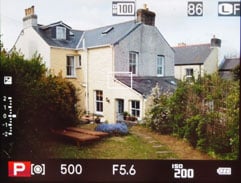 | 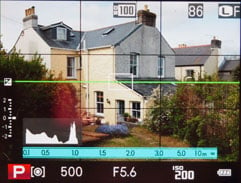 | 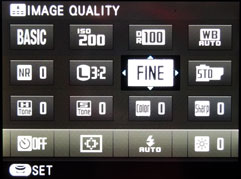 |
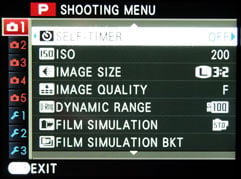 | 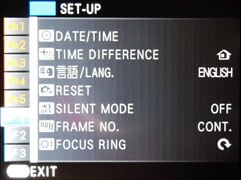 | 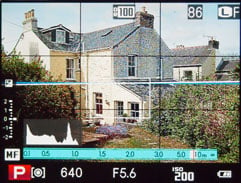 |
With both dials in the A position you get fully auto Program AE modality, Shutter and Aperture antecedence is stage set aside moving the shutter speed dial or aperture closed chain onto ace of the discrete settings and fully manual mode by setting some the shutter speed and aperture manually. This send away all make up done with your eye to the viewfinder with absolute certainty that you've got the right control. The same goes for exposure compensation, I intend it would have been prissy to feature had a physical dial for ISO settings also, but at least you can assign this to the Fn clit next to the shutter press release.
The X100's Raw button, which was extended via a microcode update, is updated to a fully functional Q menu clit which displays a function grid from which you can prize and directly change a range of settings including Custom settings, ISO sensitivity, Dynamic rove, Gabardine balance, Disturbance diminution, Image size, Film simulation, Mortal-timekeeper, and AF mode. It's a hatful suchlike the Super Control Panel on the Mount Olympus PEN Small Four Thirds mirrorless powder compact system cameras, right down to the navigation. You navigate crosswise and downfield the grid by imperative on the Command dial and change the selecting background by rotating information technology. This Bid control rif switch can also be utilized to change settings; apart from emulating the Compel telephone dial its other function is exposure control, either for Program shift or adjusting the aperture scope in 1/3EV increments between the physical whole stop settings on the lens ring.
One of the advantages of the X100S's fixed focal distance lens is that it's a good deal faster to start than a compact, which has to extend a motorised foldaway whizz. Though, to be far, the Nikon COOLPIX A is no slump in this respect. Fujifilm claims a 0.5 second startup for the X100S, a 0.5 second shooting musical interval and a shutter wai of .01 second, in practice, it took a little longer for the X100S to take the introductory shot after switching it happening and if you're in a hurry and press the shutter release before it's primed, nothing happens, so you have to secrete information technology and test again. With a little practice you can guess the delay and fire off a shot in a little over a indorsement.
Fujifilm X100S Focus
Fujifilm has been steadily up the AF performance of X-series models so that, from the unsatisfactory first performance of the X-Pro1 (since improved with a firmware ascent), things have improved to the point where the X100S competes on an equal foothold with the fastest AF systems available in compacts and mirrorless system cameras. The X100S builds on the contrast find systems of earlier X-System models, adding phase detect AF points on the sensor in addition to the existing contrast detect AF system.
In hypothesis, the crossbreed system of rules should provide faster, more reliable AF and Fujifilm claims AF speeds as fast As 0.08 seconds. Whether the X100S can actually focus faster than 10th of a indorse it's touchy to say, but information technology is significantly quicker than the COOLPIX A. In good light, with distant subjects the X100S locks focus and beeps nigh instantly. I too tested the X100S alongside the Olympus XZ-2 and it's faster than that also.
The X100S has three AF modes, AF-S, AF-C and Manual which are selected by setting a switch along the leftmost side of the body. In AF-S mode you can quality one of 25 AF areas using the Optical viewfinder, or from 49 areas if you're using the screen or EVF. Just you can buoy't shift the size of the AF area and the X100S lacks the COOLPIX A's Face priority and tracking modes.
Push the stress mode chooser to Manual and you can enjoyment the electronically-coupled lens ring to set the focus. If you're using using the screen or the EVF the image will look blurred if it's come out of the closet of focus, but that's obviously not the case with optical viewfinder. A length weighing machine is provided on all trey displays with a exfoliation that can cost displayed in Imperial or metric units, merely for the electronic displays the X100S places a couple of other useful blue-collar focus aids in your discipline of view. The showtime of these, a kind of homage to the original range finder, is the World's for the first time appendage Split image display, which displays a monochromatic area in the centre of the screen which splits the image into three flat strips which must be aligned for accurate focus.
If you prefer a more modern kind of manual focus aid, the X100S also offers Sony-style focal point peaking, which surrounds in-concenter point with a white gloriol. It's quite effective, but unlike the Sony system you can't alteration the colour or level of the highlight. Some of these systems are a real bonus in low light conditions where its often hard to tell if the focus is spot on. And this is also an reward the X100S scores over the RX1 which, remarkably, lacks Sony's focus peaking feature. One final point worth mentioning is that the concentrate ring on the X100S's lens is now much many responsive, allowing fine tuning in small increments if you move slowly, but also masking the full range with a intelligent twist.
Fujifilm X100S Continuous shot
The Fujifilm X100S offers two continuous shot speeds – 3fps for a flare-up of 44 JPEG frames or a faster 6fps grade for a bust of 31 JPEG frames. For RAW+JPEG shot, both modes are limited to 9 Frames. That’s a slight improvement connected the 5fps top speed of its predecessor and a considerable addition on its buffering capability of up to 10 JPEGs or 8 RAW frames.
To test the constant shooting performance of the X100S I fitted it with a 16GB Sandisk Extreme Pro UHS-1 card with channelize rate of 95MB/s and go down it to Large Small-grained JPEG quality. I set the labor modality to the fastest 6fps setting, set the shutter speed to 1/250 and held down the shutter release. The X100S fired away to a greater extent than 100 frames and probably would have continuing until the batting order was full. The first 60 frames sounded pretty consistent and I timed them at a charge per unit of just under 6fps, after that the rate slowed to an average of 4.5fps for the remaining frames.
Switching to Unpolished, the X100S shot 8 frames somewhat faster than 6fps before slowing to a rate of around uncomparable frame per second. The buffer took 8.6 seconds to pillaged RAW files and 4.6 seconds to empty JPEGs.
If you're shooting JPEGs the X100S provides respectable continuous shooting closely knit to the claimed 6fps rate. Past comparison, the COOLPIX A can shoot a 100-frame JPEG fusillade at a slightly slower 4.5fps, but it manages an 18 frame RAW burst at that speed, so, for JPEGs at least, the X100S is faster. It's besides worth noting that, with its hybrid optical view finder, the X100S provides a continuous view of the action while you're shot, greatly increasing the chances of a undefeated sequence, whereas with the COOLPIX A and other models that depend on a riddle you'Re always one frame behind the action.
Fujifilm X100S
Sensor
The X100S uses the same 16 Megapixel X-Trans CMOS sensor developed for the X-Pro 1 and X-E1 mirrorless compact system models. The key difference of opinion between it and conventional sensors is the emblazon filter array. In a traditional digital camera sensor, each exposure site is covered away a coloured filter arranged in a repeating form. The most common approach pattern uses a cardinal-by-deuce square set out with one red, unrivalled blue and two viridity filters; this is known as the Bayer pattern afterward the Kodak orchestrate who invented it. Software and then interprets this data to generate a full colouration trope in a process known as First State-mosaicing.
The trouble with the Bayer pattern is that very fine details bottom cause undesirable colour artefacts titled moiré. The solution on traditional camera sensors is to slightly dim the fine point using a first gear-pass filter located in front of the sensing element. This effectively reduces moiré, but at the cost of losing the finest details.
| Bayer shape: 2×2 | X-Trans pattern: 6×6 | ||
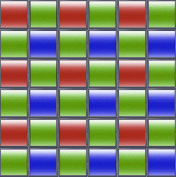 | 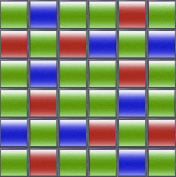 | ||
Fujifilm's X-Trans sensor claims to avoid moiré away employing a different traffic pattern of filters which Thomas More closely resembles the hit-or-miss nature of film grain. So rather of the traditional two-away-deuce Bayer convention, the X-Trans sensor employs a cardinal-by-six repetition rule with a less regular arrangement of coloured filters inside. You tin ensure how this looks in the plot different, reproduced from the Fujifilm brochure.
Fujifilm reckons this new pattern is then effective that moiré is reduced to an extent that eliminates the need for a low-hand trickle altogether. This means the full resolution of the sensor is unlocked and the company claims the 16 Megapixel X-Trans bequeath match OR even out-perform full-frame sensors.
The more multifactorial form does, nonetheless, require a much intensive de-mosaicing cognitive operation to generate a full colour image, and to cope with the come-crunching, Fujifilm has equipped the X100S with its new EXR Processor II. A new and complex pattern also needs more involved RAW processing, at the time of writing support for the X-Trans sensor's RAW files is slowly materialising with improved support in ACR 7.4.
Vibrating onto the actual photos, the X-Trans sensor delivers 3:2 wrought images with a maximum resolution of 4896×3264 pixels. 16:9 and 1:1 cropped aspect ratios are besides available, and each shape is additionally offered at two lower resolutions if desired. Images terminate equal transcribed as JPEGs, RAW files or RAW plus JPEG. The sensitivity ranges from 200-6400 ISO and is expansile down to 100 ISO and functioning to 25600 ISO. Auto ISO can Be limited to a level bes of 400 to 3200 ISO.
Whereas the exchangeable lens X-series models have a point flat shutter, the X100S is fitted with a leaf shutter. This has a shutter f number range of 30 seconds to 1/4000th, but i of the limitations of the leaf shutter is that is has a maximum speed of 1/1000 with the aperture wide open at f2.0
To see how the quality of the Fujifilm X100S measures-finished in practice, take a feel at my Fujifilm X100S quality and Fujifilm X100S noise results pages, browse my Fujifilm X100S images, or jump to the chase and head straight for my verdict.
Pages: 1 2 3 4
Fujifilm X100S review
Source: https://www.cameralabs.com/fujifilm_x100s/
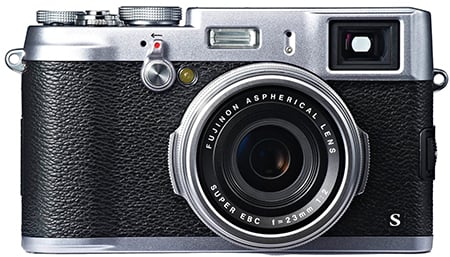
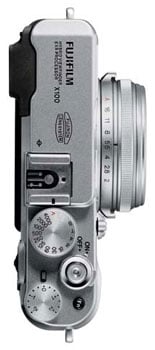




Posting Komentar untuk "Fujifilm X100S review"